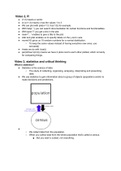Samenvatting
Summary for the course, statistical methods at VU.
- Instelling
- Vrije Universiteit Amsterdam (VU)
This summary captures all lecture video's (in the year , during the COVID breakout) of the statistical methods course, given in the second year of the bachelor AI. It captures all video's, however some examples are often not included, and some are.
[Meer zien]




